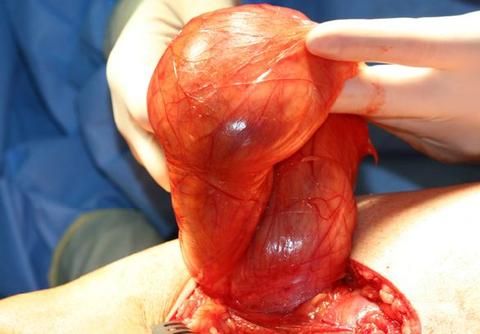The abdominal wall hernia operation is one of the most common surgical interventions in the industrialized nations, as this complication occurs in around four percent of the population. Men aged between 40 and 50 years are affected particularly frequently. There is furthermore a congenital form occurring in children which in many cases must likewise be eliminated by means of a surgical intervention.
Recommended specialists
Article overview
- Development of an abdominal wall hernia
- Hernias in various regions of the abdominal wall
- Symptoms of abdominal wall hernias
- The abdominal wall hernia operation
- Examinations prior to an abdominal wall hernia operation
- Preparations for the abdominal hernia operation
- Operation methods for abdominal wall hernia surgery
- Mesh-free procedures in abdominal hernia surgery
- Operations for abdominal wall hernias with mesh implantation
- Post-operative care after an abdominal hernia operation
- Possible complications
Abdominal wall hernia operation - Further information
The abdominal hernia operation is the standard treatment for hernias of the abdominal wall, even though in mild cases the hernial sac can indeed be successfully pushed back so that the organs are once more located at their correct locations. However, the risk of renewed protrusion is then increased, and the gap in the muscles can be enlarged by the pressure of the hernial sac, with the result that without immediate abdominal wall hernia operation, the risk of complications also increases. Parts of organs that have slipped out can for instance be pinched off, leading to painful and dangerous disturbances of the blood supply. If a part of the intestine is affected, then there is a looming threat of a life-threatening bowel occlusion. An operation performed in a timely manner in the case of an abdominal wall hernia prevents this risk. An occlusion can only be eliminated by means of an emergency abdominal hernia operation.
Development of an abdominal wall hernia
The peritoneum is the innermost layer of the abdominal wall. It covers the organs intestine, liver, stomach and spleen and secretes a secretion that, to put it in simplified terms, serves as a lubricant in order to avoid friction associated with discomfort when organs move with respect to each other. If the peritoneum protrudes through a gap in the muscles, physicians refer to this protrusion as a hernia of the abdominal wall. In this tissue sac (hernial sac), organs can also slip outside. The standard therapy is the abdominal hernia operation.
The reason why operations for abdominal wall hernias are so common is that the abdominal wall is not structured evenly. In most cases, a hernia occurs at an anatomical weak spot, for instance in the region of the navel. The formation of hernias is facilitated if the abdominal wall is not very firm, for instance due to congenial weakness of the connective tissue or declining tissue firmness in old age.
The factor that triggers the hernia and hence the subsequent abdominal hernia operation is then in most cases an unusually high pressure in the abdomen. The pressure may be permanently increased due to injuries, tumors or accumulations of water, for instance in connection with liver cirrhosis or chronic lung diseases. Or the pressure rises briefly when coughing, pressing or lifting heavy objects. Overweight, by the way, is an additional risk factor. Children that require an operation due to an abdominal wall hernia are a different story. In their case, the gap through which the peritoneum slips is normally congenital.
An abdominal wall hernia operation may furthermore become necessary after previous interventions in the body region concerned, as a hernia can more easily occur in the region of the scars. Patients should be particularly wary if the surgical wounds had become inflamed. Here again, overweight is an additional risk factor. In the subsequent abdominal hernia operation, the physicians support the weakened tissue by means of a mesh in order to prevent further hernias and subsequent abdominal wall hernia operations. Hernias are, by the way, also possible inside the body. Such hernias are rare and are always treated by means of an abdominal hernia operation.
Hernias in various regions of the abdominal wall
What form of operation is used to treat abdominal wall hernias also depends on where exactly a hernia has developed. Hernias most commonly develop in the inguinal or groin region, and these are then referred to as inguinal or groin hernias. Those affected are mostly men, because the testicles migrate down through the inguinal canal in the embryo and the canal in some cases subsequently fails to completely close again. Most abdominal hernia operations are therefore performed in the region of the groin.
The femoral or thigh hernia, on the other hand, is more common in women and is located below the inguinal ligament. Another typical hernia location is the region of the navel. Such hernias are referred to as umbilical or navel hernias. Here, too, the purpose of the abdominal wall hernia operation is to support the abdominal wall in order to prevent future hernias. Umbilical hernias in children are an exceptional case. This is the only form of hernia that may heal spontaneously within the first two years. Thus, an operation can be avoided in some cases.
A hernia in the upper abdomen (epigastric hernia), which is located between the sternum and the navel, is considerably more rare. It is almost always eliminated by means of an abdominal hernia operation. An incisional hernia after an operation can, on the other hand, occur anywhere in the abdominal wall - depending on the location of the scar after a preceding intervention.
Symptoms of abdominal wall hernias
Small hernias are often hardly noticed by those affected, because the symptoms only become manifest under exposure to strain - and an operation is unwittingly postponed. For example, the patient experiences a feeling of pressure, that may change to dragging or stinging pain as soon as he tightens his abdominal muscles. Typical situations are coughing fits, strong pressing when defecating on the toilet, or lifting heavy objects.
While an abdominal wall hernia operation is not yet mandatory at this stage, a hernia will not regress spontaneously, so that without treatment, a deterioration of the condition must be reckoned with over the course of time. Furthermore, the mobility and hence the quality of life of those affected is impaired. They try to avoid painful situations and hence also an abdominal wall hernia operation - but later on, the abdominal wall hernias will require more elaborate surgery as the hernias increase in size.
If the gap grows, the pain ultimately persists permanently, and the affected patients feel ill and often suffer from problems with stool and are even able to locate the hernia from outside by palpation. An abdominal wall hernia operation is now unavoidable. Otherwise, organs that slip out through the hernia will in the worst case be pinched off. As a result, a life-threatening bowel occlusion may for instance develop. In this case, an emergency operation is indicated. In order to avoid this situation, physicians therefore recommend to rather carry out an abdominal hernia operation at an early stage as a planned intervention.
The abdominal wall hernia operation
Experts actually only refrain from performing an abdominal wall hernia operation if the intervention itself would pose too great a risk for the patient. This is the case for instance in chronically ill patients. Should the accumulation of water in a case of liver cirrhosis for instance have led to the hernia, then the physicians must consider carefully whether they can justify exposing the patient to the stress of an abdominal hernia operation. Here, too, the decision for or against an immediate operation in the case of abdominal wall hernias depends on the size and precise location of the hernia. In other words: How likely are life-threatening complications?

Examinations prior to an abdominal wall hernia operation
Extensive diagnostics is required as a matter of course prior to an abdominal hernia operation, among other reasons in order to determine the precise location of the hernia. The physical examination starts with the patient standing upright. The patient must cough or press while the physician palpates him and in most cases feels or even sees the hernial sac. The same examination is also performed with the patient lying down. Prior to the abdominal wall hernia operation, ultrasound images (sonography) are additionally made, which also show which organs may possibly be located in the protrusion. In this way, the physician furthermore determines the urgency of surgery in the case of abdominal wall hernias. The larger the hernia and the more parts of organs get displaced outside through the protrusion, the faster the abdominal hernia operation must be performed. In some cases, for instance in the case of umbilical hernias or internal hernias, a computed tomography is additionally performed.
Preparations for the abdominal hernia operation
Abdominal wall hernia operations are among the most common interventions and can be performed without complicated preparations. The patient normally only has to be hospitalized on the day of the abdominal hernia operation. In hospital, the patient's blood is sampled. Six to eight hours prior to the planned operation, the patient is not allowed to eat or drink anymore and is also no longer allowed to smoke. A physician in charge of anesthesia (anesthetist) discusses with the patient what form of anesthesia is chosen. Whether general anesthesia is required or local anesthesia is sufficient depends on the type of abdominal hernia operation. In the case of general anesthesia, an ECG is additionally required beforehand. In any case, the patient is given sedative medication beforehand. Furthermore, the respective region of the body is shaved prior to the abdominal wall hernia operation.
Operation methods for abdominal wall hernia surgery
Several procedures are available for performing surgery in the case of abdominal wall hernias. Basically, the aim is to permanently close the existing gap via an abdominal hernia operation. Only in the case of small, uncomplicated hernias can this be accomplished exclusively via sutures. In many cases, it is necessary in the course of the abdominal wall hernia operation to additionally use a synthetic mesh to stabilize the respective region. This is implanted not only in the case of larger hernias, but also in the case of elderly patients whose connective tissue is less firm.
Meshes that are used in operations for abdominal wall hernias must be considerably larger than the gap that has developed, so that they can grow together well with the body's own tissue. Their position differs greatly. "Onlay" describes the position of the mesh between the subcutaneous fatty tissue and the abdominal muscles. If the mesh is inserted under the abdominal muscles, but over the peritoneum in the abdominal hernia operation, then this is referred to by physicians as "sublay". "Intraperitoneal onlay" (IPOM) is the technical term used for a mesh in the abdominal cavity that presses against the peritoneum from inside.
Abdominal wall hernia operations are furthermore not always carried out via an open incision. Minimally invasive procedures are in some cases also possible. In such cases, surgery for abdominal wall hernias is carried out via three small incisions, through which the physician introduces his instruments and a small camera. Which procedure is chosen for the abdominal hernia operation depends on the size and location of the hernia and on possible further complications such as adhesions due to scar tissue. The nature of the hernia - "initial hernia or recurring hernia" - as well as the patient's age are factors additionally taken into account when the physician has to decide which form of abdominal wall hernia operation he chooses.
Mesh-free procedures in abdominal hernia surgery
It is relatively uncommon for operations for abdominal wall hernias to be completed without additional mesh. This form of abdominal hernia operation is used primarily in children and teenagers, and also in the case of very small gaps. The method according to Shouldice is commonly used for instance for treating inguinal hernias. In this method, the rear inguinal wall is reinforced with the body's own tissue and in this way is reconstructed. However, this type of abdominal wall hernia operation is only possible if the tissue is sufficiently firm.
Fascial doubling according to Mayo is used for very small hernias in patients of any age. To put it in simplified terms, the surgeon, during this operation for abdominal wall hernias, sutures overlapping margins of abdominal wall layers together in the region of the defect so that the tissue becomes more stable again.
In the case of large hernias in the abdominal wall, the straight abdominal muscles are in some cases displace to the side. Here, the solution may be the abdominal wall reconstruction according to Ramirez. In this abdominal hernia operation, muscle fiber bundles are, in simplified terms, separated from each other and arranged in such a way that they close the gap in the abdominal wall. This is an abdominal wall hernia operation procedure that can be performed with an open incision or as a minimally invasive intervention.
Operations for abdominal wall hernias with mesh implantation
A mesh that is used for an abdominal hernia operation provides additional stability and is supposed to reduce the relapse rate. The most common procedure used for inguinal hernias is the open abdominal wall hernia operation according to Lichtenstein. In this procedure, the gap is closed with a synthetic mesh in onlay manner, in some cases combined with a suture.
Another surgical option is referred to as plug and patch. In the course of this inguinal hernia operation, the surgeon sutures a sort of umbrella into the hernial gap using the sublay technique and then sutures a mesh into the inguinal canal using the onlay technique.
For larger umbilical or incisional hernias, too, physicians use meshes in abdominal wall hernia operations in order to stabilize the abdominal wall which is under strong tension.
An alternative abdominal hernia operation method in the case of large incisional hernias is the sublay technique. In this technique, the scar and the hernial sac are cut out and the gap produced in this way is closed in the course of the abdominal wall hernia operation by a mesh that is placed under the straight abdominal wall muscles on both sides.
It is also possible to carry out an abdominal wall hernia operation as a minimally invasive intervention (using laparoscopy), i.e. only with small incisions. Such an operation is carried out in general anesthesia. The methods are referred to as TAPP (transabdominal preperitoneal mesh implantation) and TEP (total extraperitoneal hernioplasty). In the course of this abdominal hernia operation, the physician closes the hernial gap under the peritoneum with a synthetic mesh. The two procedures differ primarily in that in the TAPP intervention, surgery is performed via the abdominal cavity, while in the TEP intervention, an access between the peritoneum and the abdominal wall is used.
The IPOM method, on the other hand, is used for incisional or umbilical hernias. In the course of this abdominal hernia operation, the physician introduces the mesh at the side and places it over the defective area from inside.
Post-operative care after an abdominal hernia operation
After an abdominal wall hernia operation, the patients must first and foremost take care to avoid strain. While standing and walking is possible on the first day, it is better though for patients who have had surgery for abdominal wall hernias to remain lying in bed at the start. Exposure to strain may then be increased step by step. As early as two weeks after an abdominal hernia operation, all normal activities of everyday life should once more be possible, such as for instance driving a car, cycling or hiking.
Depending on the type of intervention - open or minimally invasive, light office work is once more possible already after a few days. As for sports, depending on the intensity of the sport concerned, patients should not start again doing sports until three to four weeks after an abdominal wall hernia operation. Lifting heavy objects weighing more than ten kilograms is an exception. Affected persons must wait with this for ten to twelve weeks after operations for abdominal wall hernias.
Apart from that, no special measures have to be taken after abdominal wall hernia operations. With a protective adhesive bandage on the wound, the patients may wash and take showers as normal. The physician removes the stitches about nine to twelve days after the abdominal hernia operation.
Possible complications
Operations for abdominal wall hernias, like any intervention, may entail undesirable complications. For example, nerve disorders may arise. These may be perceived by those affected as permanent pain. Wound infections, damage to testicles and thromboses are also possible in the aftermath of abdominal hernia operations. Moreover, the risk of possible general anesthesia must be considered prior to an abdominal wall hernia operation. Furthermore, a hernia may once again arise later on (recurrence), and this must then be closed by means of an additional abdominal wall hernia operation.


























